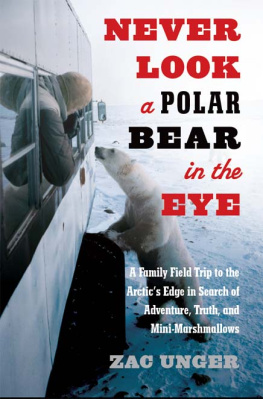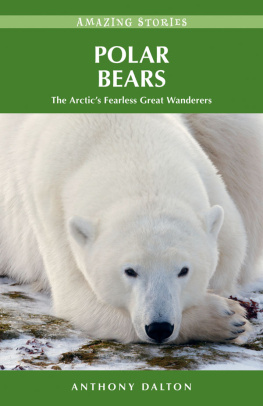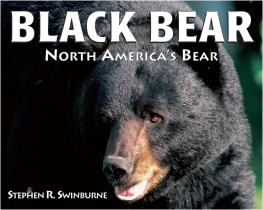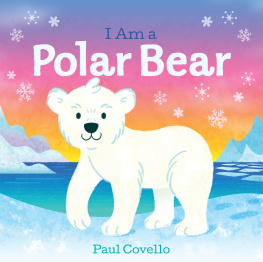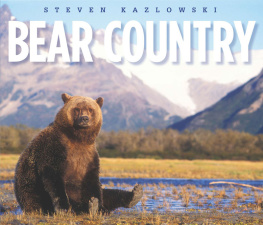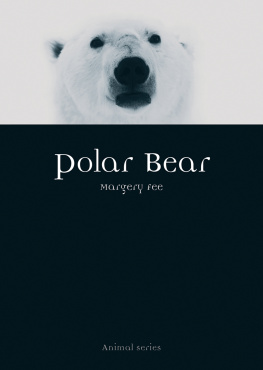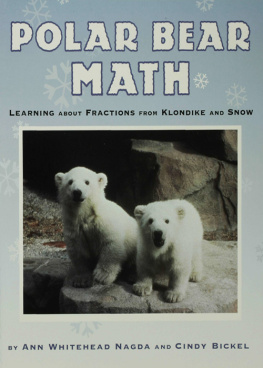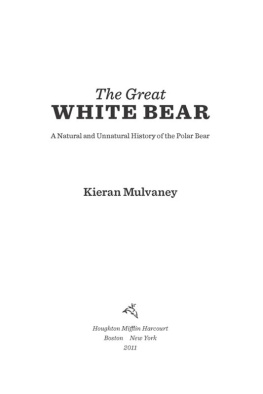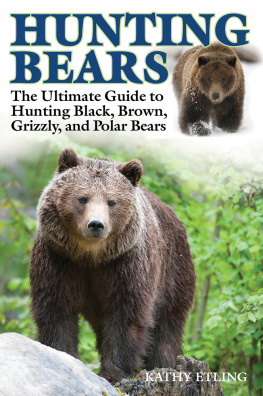NEVER LOOK A
POLAR BEAR
IN THE EYE
NEVER LOOK A
POLAR BEAR
IN THE EYE
A Family Field Trip to the Arctics Edge in Search of Adventure, Truth, and Mini-Marshmallows
Zac Unger

DA CAPO PRESS
A Member of the Perseus Books Group
Some names have been changed and dialogue is to the best of the authors recollection.
Copyright 2013 by Zac Unger
All rights reserved. No part of this publication may be reproduced, stored in a retrieval system, or transmitted, in any form or by any means, electronic, mechanical, photocopying, recording, or otherwise, without the prior written permission of the publisher. For information, address Da Capo Press, 44 Farnsworth Street, 3rd Floor, Boston, MA 02210.
Designed by Pauline Brown
Set in 11.5 point Minion Pro by the Perseus Books Group
Library of Congress Cataloging-in-Publication Data
Unger, Zac.
Never look a polar bear in the eye: a family field trip to the Arctics edge in search of adventure, truth, and mini-marshmallows / Zac Unger.First Da Capo Press edition.
p. cm
ISBN 978-0-306-82163-9 (e-book) 1. Polar bearManitobaChurchill. 2. Polar bearConservationManitobaChurchill. 3. Human-animal relationshipsManitobaChurchill. 4. Unger, ZacTravelManitobaChurchill. 5. Churchill (Man.)Description and travel. 6. Churchill (Man.)Environmental conditions. I. Title. QL737.C27U58 2013
599.7862097127dc23
2012033743
First Da Capo Press edition 2013
Published by Da Capo Press
A Member of the Perseus Books Group
www.dacapopress.com
Da Capo Press books are available at special discounts for bulk purchases in the U.S. by corporations, institutions, and other organizations. For more information, please contact the Special Markets Department at the Perseus Books Group, 2300 Chestnut Street, Suite 200, Philadelphia, PA 19103, or call (800) 810-4145, ext. 5000, or e-mail .
10 9 8 7 6 5 4 3 2 1
For Shona
Such is the economy of nature, that no instance can be produced of her having permitted any one race of her animals to become extinct; of her having formed any link in her great work so weak as to be broken.
THOMAS JEFFERSON, 1781
The complete extinction of the species of a group is generally a slower process than their production.... So profound is our ignorance, and so high our presumption, that we marvel when we hear of the extinction of an organic being; and as we do not see the cause, we invoke cataclysms to desolate the world.
CHARLES DARWIN, 1859
More than 99 percent of all species that ever lived are extinctand disappearance cannot be the biological equivalent of a scarlet letter.
STEPHEN JAY GOULD, 1992
CONTENTS
O N JANUARY 24, 2004, in the frigid moonscape of an Arctic winter, wildlife biologist Steven Amstrup rode shotgun in a helicopter flying low over the ice. He aimed an infrared heat detector at the ground, hoping to find polar bears in their dens. Hed been tracking bears for years, and the chopper-mounted heat gun was a great modern tool, one that would reduce the amount of time he would have to spend slogging through the tundra on foot and by snowmobile.
When the gun recorded a hit, Amstrup circled around for a closer look. What confronted him was something he had never seen or heard of in thirty-four years of polar research. The mouth of the den was open, and a smear of bright red blood stretched away for two hundred feet. There, at the end of a long drag trail in the ice, lay the still-warm body of a mature female polar bear. Given that the air temperature was 20F below zero, this bear could not have been dead for more than twelve hours. But the helicopter was running short on time, and Amstrup reluctantly left the scene of the carnage before he was able to figure out what had happened.
POLAR BEARS DO NOT HAVE ENEMIES. A male can weigh up to 1,500 pounds, with paws a foot wide and rows of savage teeth that are deadlier than a grizzlys. They are the unchallenged master predators in one of the harshest environments on earth. A full-grown bear slaughtered in her den is far outside the ordinary.
Amstrup and his team returned by snowmobile. Only a little additional snow had fallen, and the subzero temperatures were a crime scene analysts dream. The dead female had multiple wounds to her neck and head, and the snow was stained by heavy arterial bleeding. She had multiple bite wounds to her head, and her skull had been pierced by a long tooth that had slammed into her brain. Her hindquarter, belly, and mammaries had been partially eaten. Although they dont hibernate, pregnant mothers do build snow caves in which to deliver their fragile cubs. When Amstrup walked to the den, he peered beneath the collapsed roof. Inside he found two tiny cubs, each weighing less than five pounds. And both of them were dead, suffocated by the thick snow of the ruined cave.
There was only one explanation for this carnage. A single set of massive footprints led directly to the den. This bear and her cubs had been killed by another polar bear.
Cannibalism is not normal polar bear behavior. Ringed seals are easier to catch and have more calories per pound than bear meat. But over the course of that single field season, Amstrup witnessed two additional instances of polar bear cannibalism. On Herschel Island in the Yukon Territory, a fifteen-year-old female was found frozen and dead, her subcutaneous fat and most of her muscle eaten away. Her dependent yearling cub had escaped; a set of tracks led away to the northwest and then disappeared. The cubs chances of survival on its own were zero. A few days later and around sixty miles away, researchers witnessed an adult male bear feeding on a dead yearling. The younger bears skull had been savagely crushed; footprints revealed that the larger male had stalked this young bear, then set upon him as he lay sleeping.
Having never seen anything like this, Amstrup was shocked to stumble across three separate incidents of polar bear cannibalism in one season. But as he spoke to colleagues, he found that what he was seeing was becoming more common. Several thousand miles away, on the eastern edge of the Canadian Arctic, an adult male was reported to have consumed most of the carcass of a yearling male he had killed. The dead bears mother hovered around for two days, watching as her cub was picked apart. And a few years earlier in the Svalbard Archipelago, four hundred miles north of Norway, three small cubs were found dead inside their den. Autopsies revealed the presence of fresh milk in their stomachs; their mother had not abandoned them, yet she did not attempt to intervene as a powerful male bear killed them one by one. Elsewhere in Svalbard, researchers observed a male pursuing a mother bear and her yearling, doggedly chasing them over broken spits of ice, in and out of the frigid waters. Finally, cornered at the base of a sheer cliff, the yearling was killed by a blow to the skull. The mother fled along the coast, and the aggressive male dragged the yearling carcass to an ice floe six hundred feet offshore, where he feasted on it for days.
Back at the ravaged den he had discovered, Amstrup followed the paw prints and analyzed the blood spatters. The offending male bear hadnt just chanced upon this site. He had actively stalked it, much the way bears sneak up on the lairs of ringed seals. The footprints followed the typical hunting patternthe bear meandered around in a wide arc, then made a beeline for the spot where mother and cubs were resting. He had crashed through the roof, collapsing the snow cave and suffocating the cubs. Once inside, he held the female in place with his paws and crushed her skull with his teeth. After the struggle, the male dragged his feast to a patch of clean snow. Although polar bears have killed other polar bears in the past, this was the first recorded instance in which the killing took place at the supposedly safe haven of a denning site.
Next page
